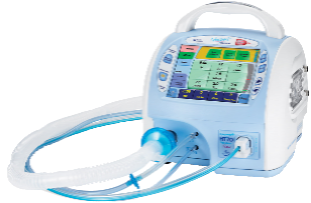
This image has format transparent PNG with resolution 311x203.
You can download this image in best resolution from this page and use it for design and web design.
Mechanical ventilator COVID-19 PNG with transparent background you can download for free, just click on download button.
Mechanical ventilation, or assisted ventilation, is the medical term for artificial ventilation where mechanical means are used to assist or replace spontaneous breathing. This may involve a machine called a ventilator, or the breathing may be assisted manually by a suitably qualified professional, such as an anesthesiologist, respiratory therapist (RT), Registered Nurse, or paramedic, by compressing a bag valve mask device. In most situations in intensive care unit, RTs are responsible for optimizing ventilation management, adjustment and weaning.
Mechanical ventilation is termed "invasive" if it involves any instrument inside the trachea through the mouth, such as an endotracheal tube or the skin, such as a tracheostomy tube. Face or nasal masks are used for non-invasive ventilation in appropriately selected conscious patients.
The two main types of mechanical ventilation include positive pressure ventilation where air (or another gas mix) is pushed into the lungs through the airways, and negative pressure ventilation where air is, in essence, sucked into the lungs by stimulating movement of the chest. Apart from these two main types, there are many specific modes of mechanical ventilation, and their nomenclature has been revised over the decades as the technology has continually developed.
The shortage of ventilators has emerged as a key aspect of the Coronavirus pandemic.
Mechanical ventilation is indicated when the patient's spontaneous breathing is inadequate to maintain life. It isalso indicated as prophylaxis for imminent collapse of other physiologic functions, or ineffective gas exchange in the lungs. Because mechanical ventilation serves only to provide assistance for breathing and does not cure a disease, the patient's underlying condition should be identified and treated in order to resolve over time. In addition, other factors must be taken into consideration because mechanical ventilation is not without its complications.
In general, mechanical ventilation is instituted to correct blood gases and reduce the work of breathing.
It can be used as a short-term measure, for example during an operation or critical illness (often in the setting of an intensive-care unit). It may be used at home or in a nursing or rehabilitation institution if patients have chronic illnesses that require long-term ventilatory assistance. Due to the anatomy of the human pharynx, larynx, and esophagus and the circumstances for which ventilation is needed, additional measures are often required to secure the airway during positive-pressure ventilation in order to allow unimpeded passage of air into the trachea and avoid air passing into the esophagus and stomach. The common method is by insertion of a tube into the trachea: intubation, which provides a clear route for the air. This can be either an endotracheal tube, inserted through the natural openings of mouth or nose, or a tracheostomy inserted through an artificial opening in the neck. In other circumstances simple airway maneuvres, an oropharyngeal airway or laryngeal mask airway may be employed. If the patient is able to protect his/her own airway and non-invasive ventilation or negative-pressure ventilation is used then an airway adjunct may not be needed.
In this page you can download free PNG images: Mechanical ventilator COVID-19 PNG images free download